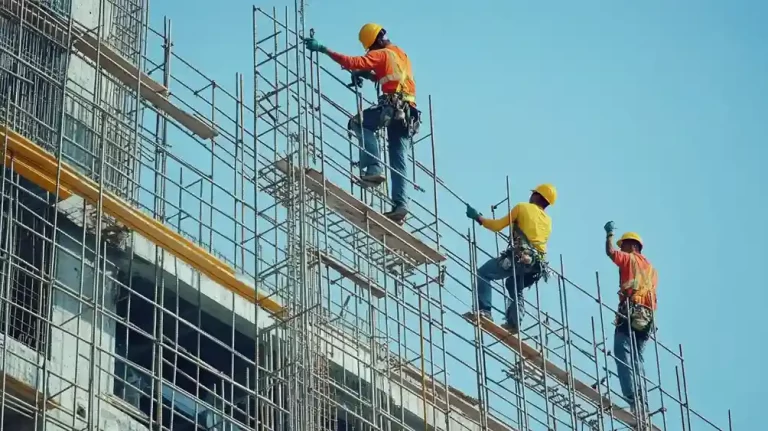Speakers: Michael Levites & Matthew Sullivan
Michael Levites: Welcome back, everybody. This is Michael Levites from JurisQ Legal Network. And I’m here with Matthew Sullivan, a partner in the Law Office of Gregory Spektor & Associates, a personal injury firm. But Matthew’s authority lies with construction excellence. So welcome back. Thank you for your time, Matthew.
Now, I want to ask you if people have heard about it. You must have seen sometimes, in ads or attorney blogs, The Scaffold Law that’s on the books of New York. You tell us what it is, and it has had some other names since then. What rights does it give to the injured parties to the injured workers in construction?
Matthew Sullivan: The Scaffold Law is also known as New York State Labor Law, Section 240. It’s called the Scaffold Law because it’s primarily associated with workers who fall from a height, who fall from a scaffold, or objects that fall from a height, again, typically from a scaffold. However, Michael, I want to make something absolutely clear before we continue our conversation; even though it’s called the Scaffold Law, it applies to ladders and any other elevated work platform that exposes workers to what is known as gravity-related risks, quick way to say, any elevated work platform where a worker can fall from or from which an object can fall.
Michael Levites: I see.
Matthew Sullivan: Now, the reason that this law was put into place, and it’s a very old law, it goes all the way back to the early 20th century, is because, as you know, New York City has some of the highest buildings, both residential and commercial in the world, and certainly the United States. And lawmakers, even back in the early 20th century, realized that to get the beautiful skyline that the viewers can see right now exposes workers to hazards and elevation-related risks.
In short, now, it is some of the most dangerous work that anyone can do. As a result, the New York State Scaffold Law, New York State Labor Law Section 240, was implemented to protect those workers. It allows for a worker to recover for any injury related to a violation of that law. What is the action of that law? It means that the owner, general contractor or construction manager will be absolutely liable in the ladder, scaffold, or other elevated work platform doesn’t properly protect the worker. In short, if a worker gets injured because the ladder shifts, the ladder moves, the scaffold shifts, and that worker falls from the ladder or the scaffold because of any sort of instability or any other real imperfection with the ladder or the scaffold. And that work will be allowed to go after the owner, general contractor for a construction site manager for their injuries. One topic I know we spoke about earlier is well-kept. Those defendants come back and say, Mr. Construction worker, you knew what you were signing up for. You knew what you were going to be exposed to. Thankfully, the New York Scaffold Law, Labor Law Section 240 prevents, prohibits the defendants from arguing that a sum of risk, an argument that the worker should have known the latter was unstable, won’t cut it. That is not a defence to the Scaffold law. It is not a defence to New York State Labor Law Section 214.
Michael Levites: I’m so glad that there is such a provision that really protects the workers who are vulnerable to these heights that, of course, New York has. Would you say that this is something like strict liability, which is a concept and law that somebody is responsible, no matter the circumstance, would you say this is an instance of strict liability?
Matthew Sullivan: Michael, you should be on this side of the screen. You’re absolutely correct. New York State Scaffold Law is strict liability. It imposes strict liability absolute liability against the owner, general contractor or construction site manager. It requires them to provide proper protection in the form of a stay ladder in the form of a stable scaffold to allow those workers to go to the heights necessary to perform their work.
Michael Levites: Very interesting, Matthew. But what possible defences would the Contractor have with this Scaffold Law? For example, what if a group of workers passed by the ladder and, by accident, bumped into it, and the person on it fell, something like that? Would that be a defence, or it’s an absolutely strict liability on the part of the site owner or contractor?
Matthew Sullivan: There are two principal defences that the construction site owners will assert when a worker is injured and indicates they should have been protected by the New York State Scaffold Law. The first is what’s known as a sole proximate cause defence. And that’s a very difficult defence to succeed on. What sole proximate cause means is a fancy legal term, for there was no other contributing factor. There was no other reason why that worker fell but for their own negligence. Another way, they were strictly liable. They were 100% liable for the incident. An example could be that, for no reason, they jumped off the ladder; there was no hazard. They could have climbed down safely.
Michael Levites: Well, it’s hard to prove, right?
Matthew Sullivan: It’s been done, but it’s almost impossible, I will say. Because how many times? Could it have been 50-50, where maybe the worker was partially negligent? Maybe they were contributorily negligent. But if the plaintiff can show if the injured worker can show that even 1% of negligence can be attributed to the owner, general contractor or construction manager because that ladder shifted the ladder shook the scaffold wasn’t permitted. Well, there goes your sole proximate cause defence. The second principal defence that is asserted is what’s known as a recalcitrant worker. And that one is still difficult but a little more likely, depending on the facts. And the recalcitrant worker defence is exactly what it sounds like. Someone told the worker that the ladder was out of service and better have some warning on it. For some reason, the worker disregarded that.
Michael Levites: Well, that makes sense. That means it’s really on him or her. If you disregard a warning sign, the owner should not be responsible.
Matthew Sullivan: I want to be absolutely clear. It’s the warning sign and the direction. The defence will have to essentially establish both. Does that happen? Yeah, that happens. You know, it’s not a perfect world, right? But the truth is, Michael, in an overwhelming majority, I mean, a supermajority of cases, the facts are with the plaintiff. Because New York State Scaffold Law is designed to protect the workers. It’s not designed to protect the insurance company. And that’s how it should be.
Michael Levites: I’m very glad to hear it. And the lesson here is that for anybody who has experienced any construction accident due to a fall of yourself from somewhere, or something that fell on you, you absolutely have a very big chance of recovery from your injuries. So don’t hesitate. Don’t be shy. Get an attorney to evaluate your case, and most likely, the ground will be found to sue for the damages. And, of course, what’s your attorney is Matthew Sullivan, a partner in the law office of Gregory Spektor & Associates, a personal injury firm that has years of experience, years of verdicts and massive settlements for victims of construction accidents. The phone number is in the bottom of the screen. Of course, what I will discuss here, is very general. If there’s a specific case, you must call an attorney and get an answer that will suit your particular case. Matthew, thank you so much. Always very engaging. Always very interesting. We appreciate your time. We’re gonna see you soon back in our sessions, have a good day. Thank you.
Matthew Sullivan: Thank you.



